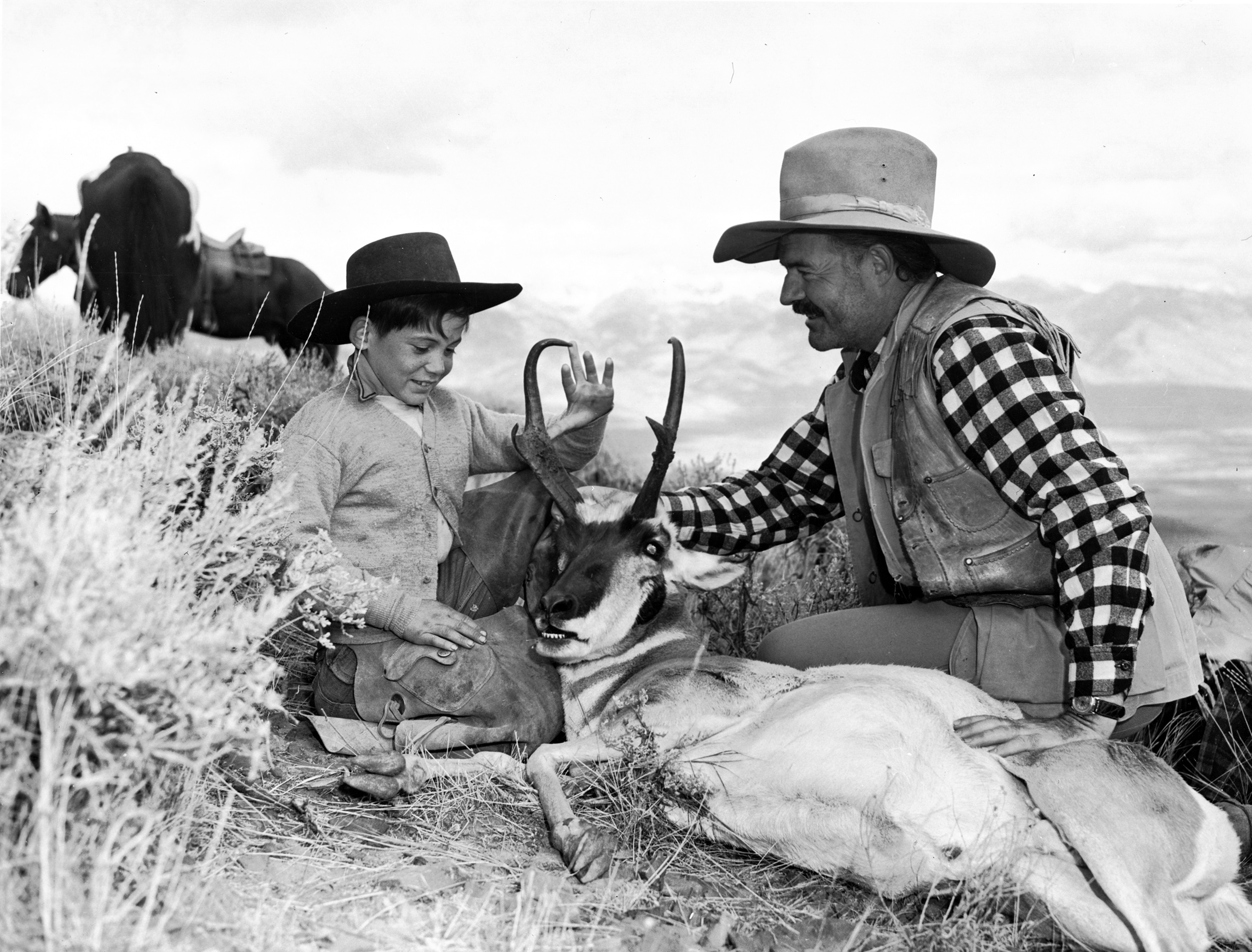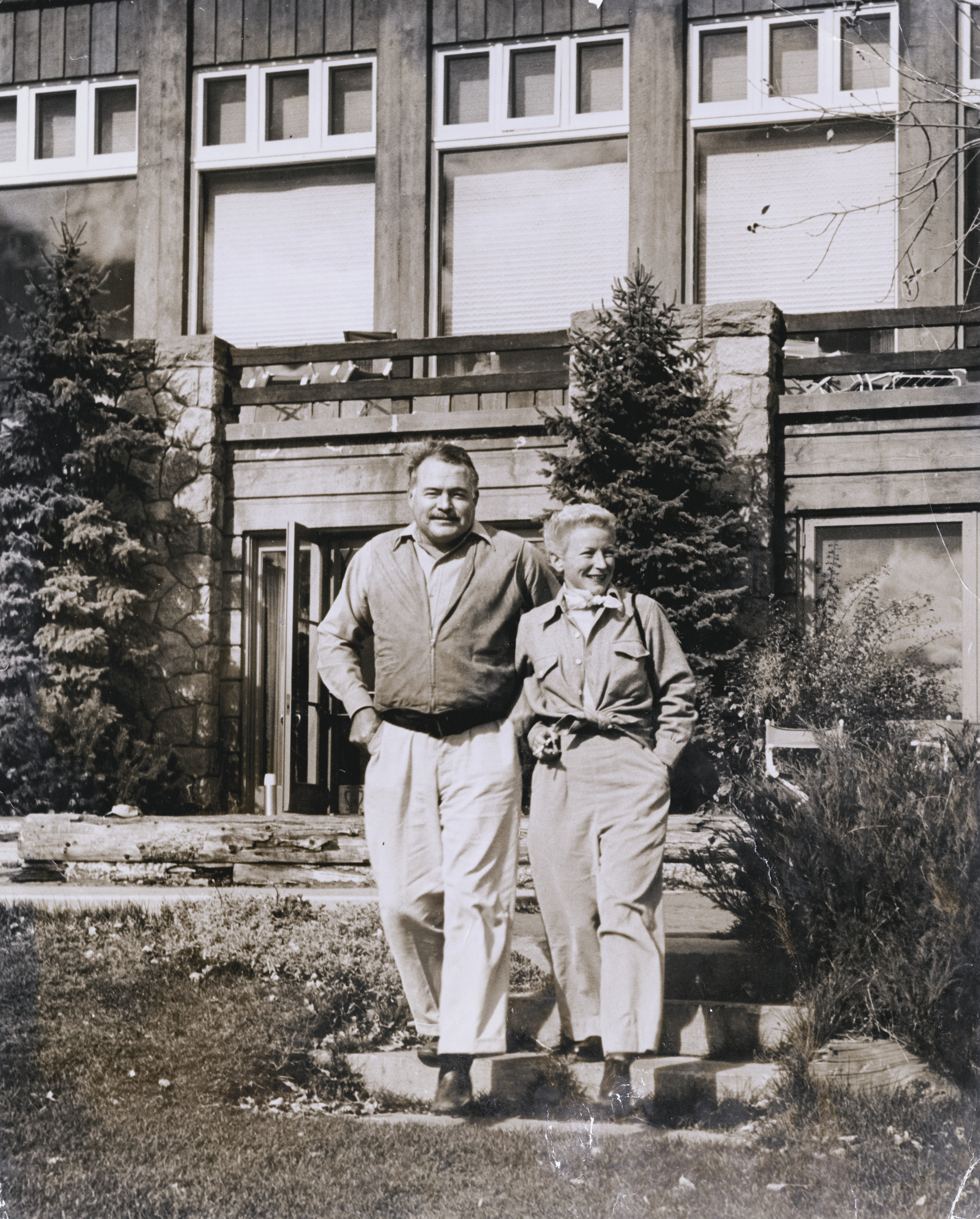Idaho
Dr. Jenny Emery Davidson (The Community Library) and Dr. Hilary Justice (JFK Library).
Updated 11/2023.
Ernest Hemingway’s twenty-two year relationship with Idaho began in 1939, deepened over many long autumn stays in the Wood River Valley, and culminated with him making his final home in Ketchum in 1959. He died by suicide there in 1961 and is buried alongside family and close friends in the Ketchum cemetery. Idaho subtly influenced several of Hemingway's later works, most notably For Whom the Bell Tolls.
Hemingway in Idaho: Chronology
1939
Hemingway first arrived in Sun Valley, Idaho, late on a September evening in 1939, driving a dusty black convertible with Martha Gellhorn (1908-1998) by his side. He had been invited to visit the new resort – part of a marketing plan by the Union Pacific Railroad’s publicity team – but he had never responded. He just showed up – with his new love interest and a car full of books, fishing and hunting gear, his typewriter, and the growing manuscript of For Whom the Bell Tolls. He was given room 206 and the run of the lodge that had been ready to close for the season.

For the next three months, Hemingway explored Idaho’s high country with local guides: He fished for trout in Silver Creek, hunted upland birds in the sagebrush hills, and rode horses in the Pioneer Mountains. He enjoyed festive dinners at the Ram Restaurant and Trail Creek Cabin, and entertained friends in his hotel suite, which came to be called “Glamour House.” He developed an abiding affection for the place and friendships that would endure the rest of his life.
1940-1941
Hemingway and Gellhorn returned in the fall of the very next year, 1940, and again in 1941, bringing the Hemingway children John (Jack), Patrick (Mouse), and Gregory (Gigi) with them for weeks full of hunting and hiking in the rugged mountains and high desert of Central Idaho. Ernest's eldest son, Jack, ultimately made his home in the Sun Valley area and raised his family there.

1946-1948
The next time Hemingway returned to Idaho he was married to Mary Welsh (1908-1986). It was 1946. They had been embroiled in the conflict of World War II, and they sought rejuvenation in Idaho’s mountains.

They traveled from Cuba to Florida, then drove across the country to Idaho. In Wyoming, Mary suffered a medical emergency from an ectopic pregnancy. She continued to recuperate in Idaho among new friends while Hemingway hunted with his sons, local friends, and celebrities Gary Cooper (1901-1961) and Jimmy Stewart (1908-1997).
Ernest and Mary Hemingway came back to Idaho for the autumns of 1947 and 1948.
1958-1961
In 1958, the Hemingways began looking to establish a permanent residence in Idaho as they planned to leave the Finca Vigía in Cuba. They bought a house along the Big Wood River in 1959, and they celebrated Christmas in the home that year.
By that time, Hemingway’s health was deteriorating. He reported high blood pressure, and friends witnessed bouts of paranoia. It was his Idaho physician, George Saviers, and local friends who helped get him to the Mayo Clinic for his first of two extended hospitalizations. After the second hospitalization, Mary and Otto "Toby" Bruce drove Hemingway back to Idaho. The next day, July 2, Hemingway died from a self-inflicted gunshot in the threshold of the home.
Over the next two decades, Mary continued to live in the home, dividing her time between there and New York City. She commemorated Hemingway’s birthday with communal parties on the lawn.
Hemingway's Relationships in Idaho
Locals and Luminaries
Sun Valley – as remote as it was in the middle of Idaho – connected Hemingway with both locals and luminaries from around the world. The new destination ski resort drew celebrities and industry elites, and Hemingway dined and hunted with politician and diplomat W. Averell Harriman (1891-1986) and film stars such as Jimmy Stewart and Clark Gable (1901-1960), becoming especially close friends with Gary Cooper. They would all often hunt with local farmers and ranchers on high desert, hardscrabble properties during the day, and then revel in the Sun Valley restaurants at night.
Hemingway forged long-standing friendships with many Idaho locals, inviting them to join him in Cuba and Spain, and maintaining warm correspondences (even asking after pet cats by name). Tillie Arnold (1905-2005) and her husband Lloyd Arnold (1906-1970), Sun Valley employees, were some of the very first people he met in 1939, and they helped arrange his future visits and kept him abreast of local happenings when he was not in Idaho.

Hemingway also became particularly fond of Taylor “Bear Track” Williams (1887-1959), an Idaho hunting and fishing guide. Local lore is that Hemingway purchased Taylor’s burial plot when he died, and Hemingway served as a pallbearer at his funeral.
"Bear Track" and the Arnolds are buried near Hemingway in the Ketchum Cemetery.
Works Inspired by or Set in Idaho
Hemingway wrote two pieces specifically about Idaho.
In 1951, he published an essay about an antelope hunt in Idaho’s Pahsimeroi Valley in True: The Man’s Magazine.
More profound is the eulogy he wrote for the Sun Valley guide and publicist Gene Van Guilder (born 1905) in the fall of 1939. Hemingway had only known Van Guilder for a month when Van Guilder was killed in a hunting accident on the Snake River in southern Idaho. The eulogy describes the Idaho landscape and Van Guilder’s relationship to it poetically, and in a way that seemed to speak for Hemingway’s own affection for the place:
“Best of all he loved the fall [. . . .] with the tawny and grey, the leaves yellow on the cottonwoods, leaves floating on the trout streams and above the hills the high blue windless skies.”
Ernest Hemingway, eulogy for Gene Van Guilder
Works Written in Idaho
When Hemingway arrived in Sun Valley in 1939, he was deep in the writing of For Whom the Bell Tolls, and over the next three months he continued to make rigorous progress on it. The Idaho high country resonated in his imagination with the landscape of Spain, as well as with the Montana setting that provides protagonist Robert Jordan’s personal backstory. Hemingway even incorporated a Sun Valley reference mid-way through the novel.
Why not marry her? Sure, he thought. I will marry her. Then we will be Mr. and Mrs. Robert Jordan of Sun Valley, Idaho.
Ernest Hemingway, For Whom the Bell Tolls
The next year, Hemingway reviewed the final galley proofs of For Whom the Bell Tolls while in Sun Valley, and in October, he received the first editions of the novel there.
In later years, Hemingway would work on Across the River and into the Trees, The Dangerous Summer, and A Moveable Feast while in Idaho.
